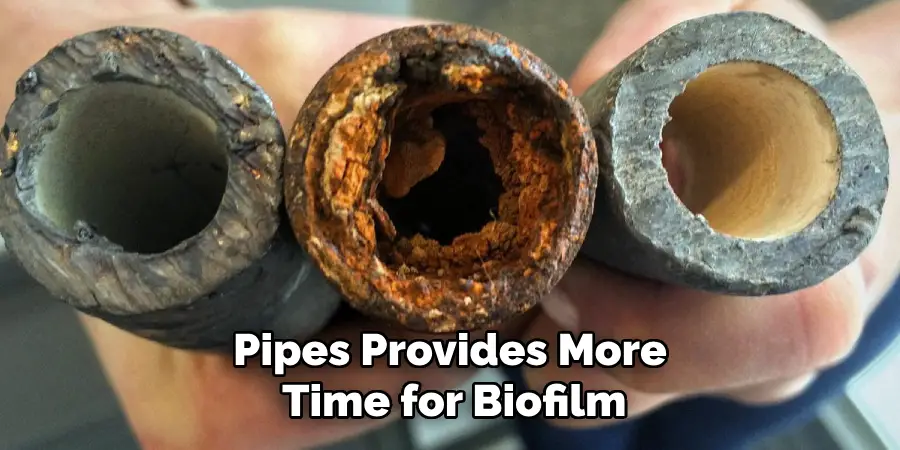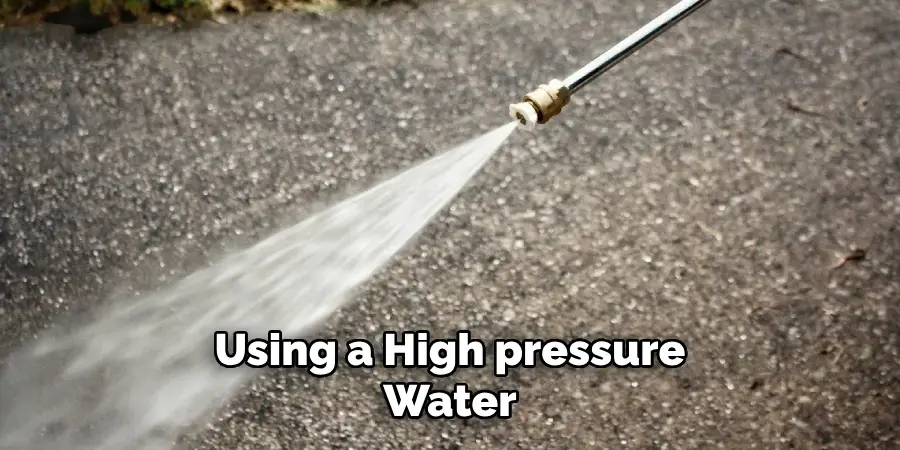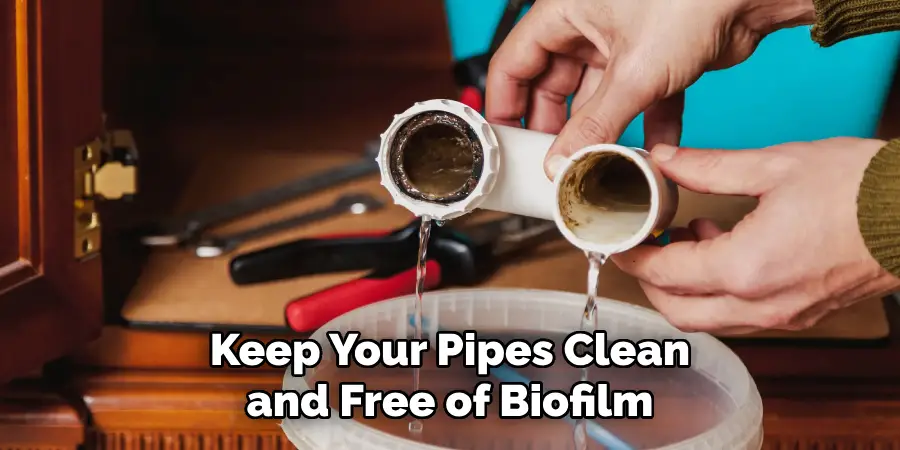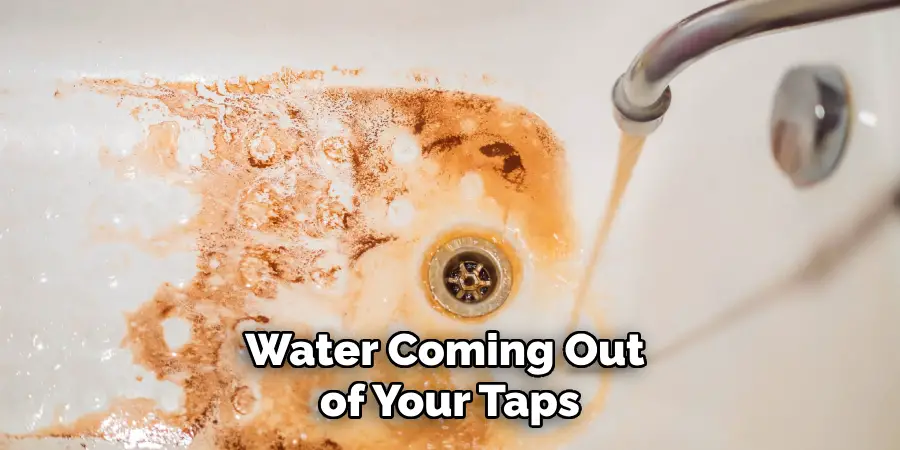Biofilm is a common problem that plagues many industries, including medical, food processing, and water treatment facilities. It is a thin layer of microorganisms that attach to surfaces and form a protective barrier against disinfectants, making it difficult to eliminate.

In pipes, biofilm buildup can cause several issues such as reduced water flow, corrosion of the pipe material, and contamination of water.
The main goal of using water pipes is to bring clean and fresh drinking water into our homes. However, biofilm can form in the pipes over time, which poses a health risk as it harbors bacteria and pathogens. This build-up also leads to reduced water flow, increased maintenance costs and an unpleasant odor. You can find step-by-step instructions on how to get rid of biofilm in pipes in this blog article.
What Causes Biofilm Formation?
Biofilm formation is a natural process that occurs when microorganisms attach themselves to surfaces. In the case of pipes, biofilm can form due to various reasons such as:
1. Presence of Nutrients
Microorganisms need nutrients to grow and reproduce, and the nutrients in tap water can provide an ideal environment for biofilm formation.
2. Warm Temperature
Most microorganisms thrive in warm environments, making the inside of pipes a suitable location for them to grow.
3. Stagnant Water
Water that sits stagnant in pipes provides more time for biofilm to form compared to regularly flowing water.

Signs of Biofilm Build-up
It is essential to identify signs of biofilm build-up in your pipes so that you can take necessary measures to get rid of it. Some common signs include:
1. Reduced Water Flow
As biofilm accumulates and grows, it can block the inside of pipes, leading to reduced water flow or even complete clogs.
2. Unpleasant Odor
Biofilm can release a foul odor, making the water taste and smell unpleasant. This is a clear indication that biofilm has formed in your pipes.
3. Discoloration
Biofilm can cause discoloration in water due to the presence of bacteria and other microorganisms. If you notice any changes in the color of your water, it may be a sign of biofilm build-up.
By paying attention to these signs, you can take timely action and prevent any further health risks or damage to your plumbing system.
Step by Step Processes for How to Get Rid of Biofilm in Pipes
Step 1: Inspect the Pipes
The first step in getting rid of biofilm in pipes is to inspect the pipes. This will help you determine the extent of the problem and which areas need to be addressed. Once you have inspected the pipes, it’s important to identify the source of the biofilm. Is it coming from a particular appliance or location? This will help you target your efforts in the right direction.
Step 2: Flush Out the Pipes
Flush out any debris or visible biofilm from the pipes using a high-pressure water jet or a cleaning solution. This will help remove any surface-level buildup and give you a clean starting point. Next, use an anti-biofilm solution to break down the biofilm and prevent it from growing back. Make sure to follow the instructions on the product carefully.

Step 3: Clean All Appliances and Fixtures
Biofilm can build up in various appliances and fixtures, so make sure to clean them thoroughly with an anti-bacterial cleaner. Pay special attention to areas such as showerheads, faucets, and drains. Hot water can help dissolve biofilm, so run hot water through your pipes for at least 15 minutes. This will also help flush out any remaining debris or bacteria.
Step 4: Use a Biofilm Removal Agent
For more stubborn biofilm buildup, you may need to use a stronger biofilm removal agent. These products are specifically designed to break down and remove biofilm from pipes. To prevent future buildup of biofilm, consider using a biofilm prevention product on a regular basis. These products can be added to your water supply or used in specific appliances to keep biofilm at bay.
Step 5: Check Your Water pH Level
Biofilm tends to thrive in water with an unbalanced pH level. Consider using a test kit to check your water’s pH and adjust it accordingly. Leaky pipes can create stagnant areas where biofilm can grow. Make sure to regularly inspect your pipes for any leaks and repair them promptly.
Step 6: Use a Water Softener
Hard water can also contribute to biofilm growth. Consider using a water softener to reduce mineral buildup in your pipes and prevent biofilm from forming. Regular maintenance is key to preventing biofilm buildup in pipes. Make sure to follow these steps periodically to keep your pipes clean and free of biofilm.
By following these steps, you can effectively get rid of biofilm in pipes and prevent it from growing back. Remember to always follow safety precautions and instructions on cleaning products when dealing with biofilm.

Safety Tips for How to Get Rid of Biofilm in Pipes
- Wear protective gear, such as gloves and goggles, when working with cleaning agents.
- Keep children and pets away from the area being cleaned.
- Use caution when handling hot water or cleaning solutions.
- Properly ventilate the area while using any chemicals.
- Avoid mixing different cleaning products together, as this can create harmful fumes.
- If you have a weak immune system or respiratory issues, consider hiring a professional to handle the biofilm removal process.
- Always read and follow instructions on cleaning products carefully to avoid any accidents or harm.
By following these safety tips, you can ensure a safe and effective biofilm removal process. Remember, prevention is key to avoiding future buildup of biofilm in pipes. Regular maintenance and proper cleaning techniques will help keep your pipes clean and functioning properly.
How Can You Prevent Biofilm From Forming in the First Place?
Biofilm buildup inside pipes can cause a variety of problems, including clogging and corrosion. Knowing how to detect it is important in order to prevent further damage. Here are some common signs that indicate the presence of biofilm in pipes.
1. Slow Moving Drains
Biofilm buildup forms a slimy layer on the inside of pipes, which makes it difficult for water to flow smoothly. If you notice that the water is draining slower than usual, it could be a sign of biofilm buildup.
2 . Foul Odor
Biofilm can produce a strong, unpleasant odor due to the bacteria present in it. This smell can be difficult to get rid of and may even spread to other areas of your home if left untreated.
3. Discolored Water
If you notice that the water coming out of your taps is discolored, it could be a sign of biofilm buildup. The bacteria in the biofilm can cause the water to become yellow or brown in color.

4. Low Water Pressure
As biofilm continues to accumulate inside the pipes, it can restrict the flow of water and cause low water pressure. This can be a frustrating problem to deal with, especially when you’re trying to take a shower or wash dishes.
5. Visible Buildup on Fixtures
In some cases, you may actually be able to see the biofilm buildup on your fixtures. It can appear as a slimy film or black spots on surfaces such as faucets and drains.
If you notice any of these signs, it’s important to take action immediately in order to prevent further damage to your pipes. The best way is to prevent it from forming in the first place.
What Are Some Common Mistakes People Make When Trying to Eliminate Biofilm From Pipes?
One of the biggest mistakes people make when trying to eliminate biofilm from pipes is not cleaning them frequently enough. Biofilms can form in a matter of hours, depending on the type of bacteria present and environmental conditions. Therefore, it’s important to establish a regular cleaning schedule and stick to it. Another mistake people often make is using harsh chemicals or abrasive materials to clean their pipes.
While these may seem like effective solutions, they can actually damage the pipes and cause more problems in the long run. It’s best to use gentle, natural cleaners and methods when dealing with biofilm.
Moisture is a key factor for biofilms to thrive, so it’s important to ensure pipes are completely dry after cleaning and that there is adequate ventilation in the area. Lastly, neglecting any potential sources of contamination can also lead to recurring biofilm problems. This could include untreated water sources or nearby equipment or surfaces that may contribute to biofilm growth.
Conclusion
In conclusion, biofilm buildup in pipes can be a major problem for many individuals and organizations. It not only affects the smooth functioning of plumbing systems but also poses a potential health hazard. However, with the right approach and proper maintenance, it is possible to get rid of biofilm in pipes.
One of the key steps to preventing biofilm buildup is regular cleaning and maintenance of pipes. This includes using appropriate cleaning agents and techniques to remove any existing biofilm and prevent its reformation. It is also important to address any underlying issues such as water quality or temperature that may contribute to biofilm growth.
I hope reading this post has helped you learn how to get rid of biofilm in pipes. Make sure the safety precautions are carried out in the order listed.

